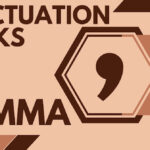Clear Communication Through Proper Use of Punctuation Marks
Introduction: The Role of Punctuation in Written Communication
The use of punctuation marks such as the full stop or period is crucial to clear written communication. Without these markers, a sentence can be ambiguous, unclear, or even incomprehensible.
Punctuation acts as an interpreter by giving context to our words and guiding the reader’s interpretation.
Definition of punctuation marks:
Punctuation marks are symbols used in writing to clarify meaning and structure by separating words or groups of words within sentences.
They allow readers to navigate text with ease and make it more readable by breaking it down into logical units.
The importance of punctuation in written communication:
Proper punctuation is essential for conveying the intended meaning accurately and unambiguously.
It helps to regulate the pace at which a sentence should be read, making it easier for readers to understand complex sentences without getting lost or overwhelmed.
The Focus on Full Stop/Period:
The full stop, also known as a period, plays a significant role in written communication.
Its primary function is to mark the end of a sentence that makes a complete thought or idea. This simple yet powerful symbol indicates where one thought ends and another begins – allowing readers to identify the sentence’s structure easily.
In short, using proper punctuation not only improves readability but also makes us more effective communicators – allowing us to convey our messages with greater clarity and precision
. In the following sections, we’ll take an in-depth look at the importance of specific punctuation marks such as full stops/periods- exploring their definition, rules for usage- followed by example sentences that demonstrate how they can be used effectively in different contexts.
Full Stop/Period Explanation
Definition and Purpose of Full Stop
The full stop, also known as a period in American English, is one of the most common punctuation marks used in written communication. It is used to indicate the end of a sentence that makes a statement or declaration.
The full stop serves as an important indicator for readers, helping them to determine when one sentence ends and another begins.
In addition to signaling the end of declarative sentences, full stops are also used after abbreviations and initials.
For example
“Dr.” and “Mrs.” are both followed by a full stop. Similarly, when using initials such as J.K Rowling or H.G Wells in writing, each initial is separated by a full stop.
Placement in Sentences and Its Effect on Meaning
The placement of a full stop within a sentence can have a significant impact on its meaning. When placed at the end of a sentence, it signals to the reader that the thought or idea presented within that sentence is complete.
However, if placed elsewhere in the middle of a sentence, it can create ambiguity or confusion about where one thought ends and another begins. For example:
– “She cooked him dinner” has only one interpretation when used with a period/full stop. – However, without it i.e., “She cooked him dinner but he was not satisfied”, there becomes two interpretations – either she wasn’t satisfied with what she made OR he wasn’t happy with his food.
Different Names for Full Stop in Other Languages
While English-speaking countries refer to this punctuation mark as either a full stop or period, other languages may use different names for it. For instance: – In Spanish language textbooks often refer to this punctuation mark as el punto.
– In French language textbooks often refer to this punctuation mark as un point. – In German language textbooks often refer to this punctuation mark as ein Punkt.
Understanding the various names for the full stop in other languages can be particularly useful for writers who may be working with individuals who speak different languages.
It is important to use the appropriate terminology when communicating with people in order to ensure clarity and understanding.
Rules for Using Full Stop in Sentences
The full stop or period is one of the most commonly used punctuation marks in English writing. It is used to indicate the end of a sentence and to separate sentences from one another.
Correct usage of full stops can dramatically improve the clarity and readability of your writing, making it easier for your readers to understand what you are trying to say.
Here are some important rules that you should keep in mind when using full stops:
Use at the End of a Declarative Sentence
A declarative sentence is a statement that makes a declaration or expresses an opinion. It tells something, gives information or explains something.
For example: “John went to the store.”
In this case, use a full stop at the end of the sentence as it indicates that this is the end of John’s action and there will be no more information added.
However, keep in mind that not all sentences are declarative sentences, so not all sentences require a full stop at their end. For instance,
imperative sentences (giving commands), interrogative sentences (asking questions) and exclamatory sentences (expressing emotion) follow different rules about punctuations such as question marks or exclamation points instead.
Use After Abbreviations
An abbreviation is a shortened form of a word or phrase such as “Mr.” for Mister” or “Dr.” for Doctor”. Using abbreviations help speed up reading times when they’re commonly known and accepted within their context.
However, if they appear at the end of a sentence, you still need to add a full stop after them. For example: “Mr. Smith went to Paris.” This sentence includes an abbreviation followed by a declarative statement which must be ended with a full stop.
Use After Initials
Initials are the shortened forms of a person’s name that uses only the first letter(s) of each name. For example, “J.K. Rowling” for Joanne Kathleen Rowling.
Like abbreviations, initials require a full stop after them when used in sentences. For instance: “H.G. Wells wrote science fiction.” In this sentence “H.G.” is considered an initial and followed by another declarative statement thus requiring a full stop at the end.
Do Not Use After Question Marks or Exclamation Mark
Question marks and exclamation points indicate different tones or emotions than the neutral statement that ends with a period/full stop.
Therefore, they require different punctuation marks to indicate their distinct function of asking questions (?) or expressing excitement (!). It is important to keep this in mind to avoid confusing your reader.
For example: “What time is it?” and “Wow! Look at that view!” Both require question mark and exclamation point respectively to indicate these are not just declarative sentences but pose questions or express excitement as well.
Following these rules will ensure that you accurately use full stops in your writing to help aid communication clarity while minimizing confusion for readers.
Understanding correct punctuation usage can make your writing more effective and improve its overall readability.
Example Sentences with Full Stop
Declarative Sentences: Simple and Precise
Declarative sentences are simple statements that make a point or declare a fact. These sentences always end with a full stop, also known as a period.
For example
“She went to the store.” The sentence is clear and precise, conveying exactly what happened without any ambiguity.
Similarly, “He is a doctor.” This sentence tells us that someone is a doctor and nothing more. Notice how the period at the end of each sentence provides closure and clarity.
Using full stops in declarative sentences helps in avoiding run-on sentences or confusing fragments that may not adequately communicate your message.
It also assists a reader in understanding the intended meaning of your content clearly and quickly.
Abbreviations: Shortening Words for Clarity
Abbreviations are often used to shorten words or phrases for ease of use and clarity in communication. Abbreviations must always have a full stop at the end to signify their shortening.
For instance, “Dr.” shortens ‘doctor,’ while “Mr.” shortens ‘mister’ and “Mrs.” ‘missus.’ Other examples include ‘Jr.’ for junior or ‘etc.’ for et cetera.
The use of abbreviations can help minimize confusion among readers by providing an easy-to-read format that delivers important information efficiently.
However, it is crucial to define an abbreviation before using it, especially when writing content directed toward an unfamiliar audience.
Initials: Using First Letters for Formality
Another common way to shorten words in written communication is through initials. Initials are used when referring to someone’s name where only first letters of each word are included; however, these initials must always have full stops between them for clarity purposes – like “J.K Rowling” or “H.G Wells.”
Using initials in documents and other written content provides a more formal and professional tone that is suitable for various contexts, particularly in legal or academic writings.
It is, therefore, wise to know when and where to use initials in the appropriate settings.
Questions without Full Stops: An Exceptional Case
While full stops are used at the end of most sentences, there is an exception when it comes to questions. Unless a question is an abbreviation, it never ends with a full stop.
For example, “What time is it?” or “Where are you going?” In interrogative sentences like these, question marks take the place of full stops.
In essence, adding a full stop in interrogative sentences would indicate that the sentence has come to a complete halt instead of leading onto another thought.
Consequently, this would alter the intended meaning behind the sentence – making it essential to stick with using question marks at all times when crafting questions.
Conclusion
Proper Punctuation: The Key to Effective Communication
In today’s fast-paced world, written communication has become increasingly important. With the advent of email, social media, and texting, messages can be sent and received in seconds.
However, in the rush to communicate quickly, many people overlook the importance of proper punctuation. Specifically, the use of full stops at the end of sentences is a key component of clear and effective communication.
Without proper punctuation, sentences can be difficult to understand or even misleading. For example, a sentence without a full stop can create confusion about whether it is a statement or a question.
Additionally, incorrect placement of full stops can completely change the meaning of a sentence. Therefore, understanding the rules for using full stops is essential for effective written communication.
The Significance of Clear Communication
Clear communication is vital in all areas of life – from personal relationships to professional settings.
When we communicate clearly and effectively through our writing, we are able to convey our thoughts and ideas with precision and accuracy. This leads to better understanding between individuals or groups.
Proper use of punctuation marks such as full stops not only enhances clarity but also presents us as competent writers who pay attention to detail. In today’s society where most business transactions have gone online (especially during this pandemic period), your ability to write effectively can determine how successful you are in your career.
This is why it is important that we take time out to understand these seemingly trivial rules.
Proper use of punctuation marks such as full stop should not be overlooked when communicating through writing – it could make all the difference in how your message is perceived by your audience!





4 thoughts on “Full Stop /Period Explanation”